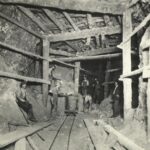The Ingersoll-Sergeant pneumatic rock drill stands in front of the Rountree Hall Apartments in Platteville, serving as an important symbol of Platteville’s mining history. The drill was manufactured by the Ingersoll-Sergeant Rock Drill Co. sometime between 1888 and 1905. Continued improvements in drilling technology provided more efficient drills, retiring this model from use. In the mid-1950s, the drill was placed on display in front of Rountree Hall at the Wisconsin Institute of Technology, formerly known as the Wisconsin Mining Trade School. The drill has been repeatedly painted with black paint over the years for display purposes, covering its original steel color. The effects of years of outdoor display can be seen on the drill up close, as lichens have begun to grow on the drilling mechanism and the embossed company information has worn away.
Although Rountree Hall is an apartment complex today, the drill reminds us of the building’s former role in technical mining education. Established in 1907, the Mining School educated students on the operation of the Ingersoll-Sergeant rock drill and other equipment. It is possible that the very drill on display was used as a model in the school’s lessons.
The Ingersoll-Sergeant Drill Co. was formed in 1888 in New York City. The company’s founder, inventor Henry Clark Sergeant, improved upon earlier designs by applying his patented air compressor to the design of the drill. This allowed the drill to be powered by compressed air, which marked an improvement over earlier steam-powered models. A single miner could operate the drill, which has a valve that connects to a hose from a compressed air source. The compressed air powered the internal mechanism that pushed and rotated the drill bit.

To correctly operate the drill, a miner would secure the tripod stand, control the amount of compressed air entering the machine, and drill circular holes in the rock to insert dynamite. Later designs of pneumatic drills by the Ingersoll-Sergeant Drill Co. contained two valves, one for compressed air and one for water. The water valve connected to a water source through a hose and was controlled by the miner. The water cooled the machine and cleaned the drilling hole of particles.
The pneumatic drill was a significant technological improvement that helped to power Platteville’s mining industry into the twentieth century. By the late 1800s, the lead that originally brought mining operations to Platteville had mostly run out. However, large deposits of zinc remained deeper underground. Improvements in water-pumping methods allowed miners to access the zinc deposits, and more efficient pneumatic drills increased the production of zinc mining operations. These developments led to Platteville’s “zinc boom” of the early 1900s, where over 31 joint-stock mining companies were incorporated in Platteville alone in 1905 and 1906. Furthermore, the commercial zinc mining companies required that miners be expertly trained in the new inventions, such as the pneumatic drill, that were powering the industry. This provided the impetus for the Mining School to be established, laying the foundation for the legacy of engineering education in Platteville that continues today with the University of Wisconsin-Platteville.
Written by Liam Reinicke, December 2022.
SOURCES
Erik Flesch, Museum Director of The Mining and Rollo Jamison Museums, in discussion with the author, March 2022.
Fred Herbert Colvin and Lester Gray French, “Obituary: Henry Clark Sergeant,” Machinery 13, no.1 (1906): 410-411
Henry Clark Sergeant. 1878. Improvement in Rock-Drills. US Patent 202,060, filed January 2, 1878, and issued April 2, 1878.
W.L. Saunders, “The History of the Rock Drill,” Mines and Minerals 31, no.1 (1910): 18-19.





